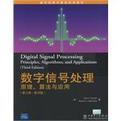数字信号处理
出版时间:2004-9-1 出版社:中国电力出版社 作者:John G.Proakis,Dimitris G.Manolakis 页数:968
Tag标签:无
内容概要
为了给读者在理论和实践应用之间进行合理的平衡,本书严谨地介绍了现代数字信号处理的基本概念和技术,并介绍了相关的算法和应用。本书涵盖了线性离散时间系统分析的时域和频域方法,还涉及了诸如采样、数字滤波器设计、滤波器实现、去卷积、插值、状态矢量空间方法、频谱分析等相关主题的内容。本书不仅要求对诸多示例、练习的理解,而且更强调对数字信号算法进行软件实现的实践环节。
本书特点:
·覆盖离散傅立叶变换(DFT)和快速傅立叶变换(FFT)算法,并对其进行了更加合理清晰的重组——介绍DFT,并在阐明傅立叶分析后描述其快速计算
·描述模拟信号模数转换中涉及的运算和技术
·在时域研究线性时不变离散时间系统和离散时间信号的特性
·考虑双边z变换和单边z变换,并描述了求z反变换的方法
·在频域分析信号与系统,给出连续时间信号与离散时间信号的傅立叶级数与傅立叶变换
·实现无限冲激响应(IIR)与有限冲激响应(FIR)系统的结构形式,包括直接型、级联型、并联型、格型和格梯型
·采样频率转换基础与多采样率转换系统
·功率谱估计的详细测试,并讨论了非参数方法、基于模型的方法和基于特征分解的方法,包括MUSIC算法和ESPRIT算法
·全书囊括了许多实例,并提供大约500个可解决的问题
本书既适合作为本科生学习离散系统和数字信号处理课程的教材,又适合研究生一年级学习数字信号处理课程时作为教材使用。
作者简介
John
G.Proakis长期担任美国东北大学的电气工程教授,并担任该校电气与计算机工程系主任之职达14年之久。他分别从麻省理工学院和哈佛大学获得了硕士和博士学位。Proakis教授是众多成功教材的作者,其教材在世界上具有相当的影响力。
书籍目录
PREFACE
1 INTRODUCTION
1.1 Signals,Systems,and Signal Processing
1.1.1 Basic Elements of a Digital Signal Processing System
1.1.2 Advantages of Digital over Analog Signal Processing
1.2 Classification of Signals
1.2.1 Multichannel and Multidimensional Signals
1.2.2 Continuous-Time Versus Discrete-Time Signals
1.2.3 Continuous-Valued Versus Discrete-Valued Signals
1.2.4 Deterministic Versus Random Signals
1.3 The Concept of Frequency in Continuous-Time and Discrete-Time
Signals
1.3.1 Continuous-Time Sinusoidal Signals
1.3.2 Discrete-Time Sinusoidal Signals
1.3.3 Harmonically Related Complex Exponentials
1.4 Analog-to-Digital and Digital-to-Analog Conversion
1.4.1 Sampling of Analog Signals
1.4.2 The Sampling Theorem
1.4.3 Quantization of Continuous-Amplitude Signals
1.4.4 Quantization of Sinusoidal Signals
1.4.5 Coding of Quantized Samples
1.4.6 Digital-to-Analog Conversion
1.4.7 Analysis of Digital Signals and Systems Versus Discrete-Time
Signals and Systems
1.5 Summary and References
Problems
2 DISCRETE-TIME SIGNALS AND SYSTEMS
2.1 Discrete-Time Signals
……
2.2 Discrete-Time Systems
2.3 Analysis of Discrete-Time Linear Time-Invariant Systems
2.4 Discrete-Time Systems Described by Difference Equations
2.5 Implementation of Discrete-Time Systems
2.6 Correlation of Discrete-Time Signals
2.7 Summary andReferences
Problems
3 THE Z-TRANSFORM AND ITS APPLICATION TO THEANALYSIS OF
LTlSYSTEMS
3.1 The z-Transform
3.2 Properties o fthe z-Transform
3.3 Rational z-Transforms
3.4 Inversion of the z-Transform
3.5 The One-sided z-Transform
3.6 Analysis of Linear Time-Invariant Systems in the z-Domain
3.7 Summary and References
Problems
4 FREQUENCY ANALYSIS OF SIGNALS AND SYSTEMS
4.1 Frequency Analysis of Continuous-Time Signals
4.2 Frequency Analysis of Discrete-Time Signals
4.3 Properties of the Fourier Transform for Discrete-Time
Signals
4.4 Frequency-Domain Characteristics of Linear Time-Invariant
Systems
4.5 Linear Time-Invariant Systems as Frequency-Selective
Filters
4.6 Inverse Systems and Deconvolution
Problems
5 THE DISCRETE FOURIER TRANSFORM:ITS PROPERTIES AND
APPLICATIONS
5.1 Frequency Domain Sampling:The Discrete Fourier Transform
5.2 Properties of the DFT
5.3 Linear Filtering Methods Basedon the DFT
5.4 Frequency Analysis of Signals Using the DFT
5.5 Summary and References
Problems
6 EFFICIENT COMPUTATION OF THE DFT:FAST FOURIER TRANSFORM
ALGORITHMS
6.1 Efficient Computation of the DFT:FFT Algorithms
6.2 Applications of FFT Algorithms
6.3 A Linear Filtering Approach to Computation of the DFT
6.4 Quantization Effects in the Computation ofthe DFT
6.5 Summary and References
Problems
7 IMPLEMENTATION OF DISCRETE-TIME SYSTEMS
7.1 Structures for the Realization of Discrete-Time Systems
7.2 Structures for FIR Systems
7.3 Structures for IIR Systems
7.4 State-Space System Analysis and Structures
7.5 Representation of Numbers
7.6 Quantization of Filter Coefficients
7.7 Round-Off Effects in Digital Filters
7.8 Summary and References
Problems
8 DESIGN OF DIGITAL FILTERS
8.1 General Considerations
8.2 Design of FIR Filters
8.3 Design of IIR Filters From Analog Filters
8.4 Frequency Transformations
8.5 Design of Digital Filters Based on Least-Squares Method
8.6 Summary and References
Problems
9 SAMPLING AND RECONSTRUCTION OF SIGNALS
9.1 Sampling of Bandpass Signals
9.2 Analog-to-Digital ConverSion
9.3 Digital-to-Analog Conversion
9.4 Summary and References
Problems
10 MULTIRATE DIGITAL SIGNAL PROCESSING
10.1 Introduction
10.2 Decimation by a Factor D
10.3 Interpolation by a Factor I
10.4 Sampling Rate Conversion by a Rational Factor I/D
10.5 Filter Design and Implementation for Sampling-Rate
Conversion
10.6 Multistage Implementation of Sampling-Rate Conversion
10.7 Sampling-Rate Conversion of Bandpass Signals
10.8 Sampling-Rate Conversion by an Arbitrary Factor
10.9 Applications of Multirate Signal Processing
10.10 Summary and References
Problems
11 LINEAR PREDICTION AND OPTIMUM LINEAR FILTERS
11.1 Innovations Representation of a Stationary Random
Process
11.2 Forward and Backward Linear Prediction
11.3 Solution of the Normal Equations
11.4 Properties of the Linear Prediction-Error Filters
11.5 AR Lattice and ARMA Lattice-Ladder Filters
11.6 Wiener Filters for Filtering and Prediction
11.7 Summary and References
Problems
12 POWER SPECTRUM ESTIMATION
12.1 Estimation of Spectra from Finite-Duration Observations of
Signals
12.2 Nonparametric Methods for Power Spectrum Estimation
12.3 Parametric Methods for Power Spectrum Estimation
12.4 Minimum Variance Spectral Estimation
12.5 Eigenanalysis Algorithms for Spectrum Estimation
12.6 Summary and References
Problems
A RANDOM SIGNALS,CORRELATION FUNCTIONS,AND POWER SPECTRA
B RANDOM NUMBER GENERATORS
C TABLES OF TRANSITION COEFFICIENTS FOR THE DESIGN OF
LINEAR-PHASEFIRFILTERS
D LIST OF MATLAB FUNCTIONS
REFERENCES AND BIBLIOGRAPHYR1
INDEX
图书封面
图书标签Tags
无
评论、评分、阅读与下载
